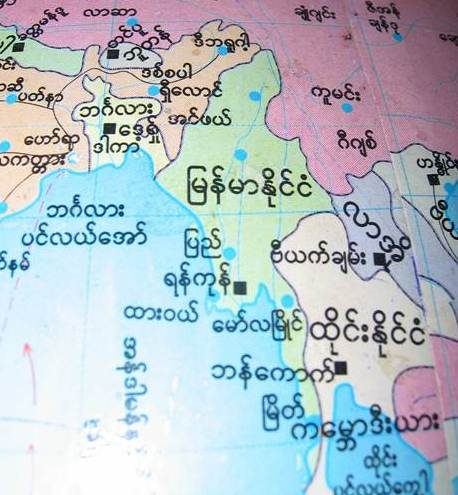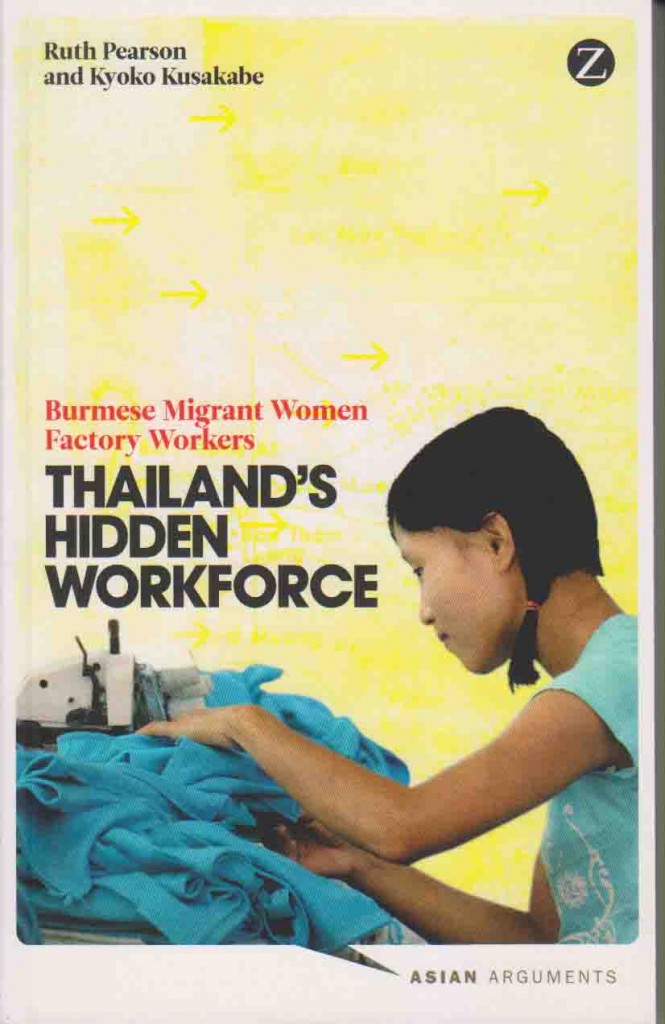Ruth Pearson and Kyoko Kusakabe, Thailand’s Hidden Workforce: Burmese Migrant Women Factory Workers
London and New York: Zed Books, 2012. Pp. x, 205; map, figures, appendices, notes, bibliography, index.
Reviewed by Inga Gru├Я
The controversial treatment of Rohingya people in Thailand has recently reminded the public that Myanmar’s much-acclaimed reforms have yet to yield tangible results for the majority of that country’s population. People continue to leave Myanmar to seek better livelihoods elsewhere. In Thailand, more than one million migrants from Myanmar have recently registered as legal residents with the right to work. There are quite probably at least another million leading undocumented lives in the country. In addition to these migrants already living in Thailand, some of them for decades, more people from Myanmar continue to arrive every day.
Ruth Pearson’s and Kyoko Kusakabe’s Thailand’s Hidden Workforce: Burmese Migrant Women Factory Workers draws attention to the conditions that female migrants from Myanmar encounter as factory workers in Thailand. The authors collected data on female migrant workers through interviews, surveys and work-shops. They worked with a team of Thai and Myanmar researchers in and around Mae Sot, Sangkhlaburi and Samut Prakan. Throughout the book, the authors offer insight into the diverse perspectives and experiences of their female informants by reproducing quotations from interviews.
The title of the book introduces the reader to the core of the authors’ agenda. Pearson and Kusakabe want to draw attention to the unnoticed and unappreciated lives of thousands of women who are considered, if at all, mere cogs in the wheels of global chains of production. According to the authors, the South – South migration of women has hardly been written about. But the “hidden” of their title refers not only to the roles of the women under study as an integral yet ignored part of global chains of production, but also to their position as a population from Myanmar living in exile. Far smaller refugee populations from Myanmar living in Thailand have achieved far higher visibility than migrant workers.
The main argument of Thailand’s Hidden Workforce is summarized in its first sentence: “This book tells the story of women who migrate from Burma to work, as part of a large and exploited workforce, in Thailand’s export factories” (page 1). Pearson and Kusakabe treat concepts such as exploitation and abuse as central to interpreting and understanding the lives of Myanmar female migrant workers in contemporary Thailand. The seven chapters of their book provide, however, insight into a wider array of matters than merely work conditions. The changing structure of the Thai economy, labour policies, state power and illegality, motivations for migration and the impact of the global economic crisis are each discussed in the book.
Of all the chapters in the book, its fifth provides the richest analysis. The chapter deals with motherhood and the many challenges that migrant women face in raising children as itinerant workers. The chapter illustrates effectively the difficult choices that women have to make with regard to family planning, child care and the setting in which they want their children to grow up. The voices of the different women quoted in the chapter illustrate that these women are agentive beings who have made decisions and choices about their own lives. Often, the conditions under which they have had to make these choices are severely limited by structural impediments. In the passages from interviews that the authors share with the reader, female migrants rarely describe themselves as victims of exploitative structural conditions. The women rather emerge as daughters, mothers, wives and friends to others, as people who seek fulfillment outside the workplace.
Nearly fifteen years ago, Mary Beth Mills published Thai Women in the Global Labor Force: Consuming Desires, Contested Selves (1999). That book has interesting parallels to Pearson’s and Kusakabe’s book. Both books illustrate the ways in which women address questions of agency, autonomy and coming-of-age in largely conservative societies. Reading the books side by side, the reader can see shifts that have occurred over time. Reading Thailand’s Hidden Workforce led me to imagine female factory workers from Myanmar today sitting in the chairs or standing along the production lines where Thai women would have sat or stood a decade and a half ago. I continue to think about the different interpretations that the authors of the two books imposed on the scenarios that they beheld during their respective periods of research. Mills firmly believed in the emancipatory power of factory work for Thai women, while Pearson and Kusakabe have chosen to emphasize the unequal power relationships into which these mostly young women step on the factory floor.
Pearson and Kusakabe have a tendency to approach the lives of these female migrant workers as policy issues. The reader is led to believe that adjusting policies will result in the betterment of the lives of these women. There is no doubt that many policies urgently require attention and improvement in Thailand. It is unlikely, though, that more migrant-friendly policies will remove all the hardship that these women experience. More ethnographic data would have provided a richer sense of what matters to these women and what changes are needed to make their lives easier. Furthermore, they would have rounded out a sometimes one-dimensional representation of the women’s lives.
Having done ethnographic research among Myanmar migrant workers in Thailand myself, I would have loved to hear from women who work outside factories. Many of the women whom I met in other parts of Thailand expressed envy of women working in factories in places like Mae Sot or Samut Prakan. Some of these women had worked on factory floors; others romanticized factory work in comparison to the construction or plantation work that they did. The community that they imagined or had experienced among fellow workers on a factory floor mattered more to them than the restrictive work environment that factory work brings. Knowing that it is not possible to do justice to the diverse perspectives and opinions of tens of thousands of women in one book, I do wonder what other blind spots the emphasis of Thailand’s Hidden Workforce on the violation of workers’ rights may have created.
Overall, this book provides a thoughtful diagnostic tool for thinking about urgently needed reforms, and about the implementation and enforcement of these reforms. It reminds the reader of the importance of holding the Thai and Myanmar states accountable for the often appalling work conditions of the itinerant workers of whom Pearson and Kusakabe give us a glimpse.
Inga Gru├Я is a doctoral candidate in anthropology at Cornell University. She is writing a dissertation drawing on eighteen months of ethnographic field-work among migrants from Myanmar on the west coast of southern Thailand.
Reference
Mills, Mary Beth. Thai Women in the Global Labor Force: Consuming Desires, Contested Selves. New Brunswick, N.J.: Rutgers University Press, 1999.
 Facebook
Facebook  Twitter
Twitter  Soundcloud
Soundcloud  Youtube
Youtube  Rss
Rss 
